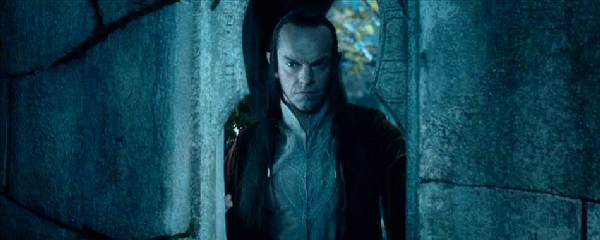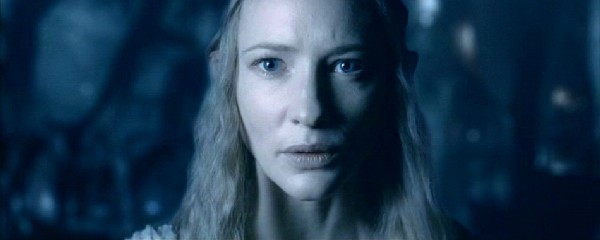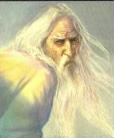3.06.*d. Breath of Life by Figwit

How does it happen in the movie?
After Aragorn has fallen off the cliff, he floats on the water. We see him wash upon the shore, and a vision of Arwen hovers over him, kissing him and giving him the blessing of the Valar.
In the next scene, we see Arwen in her bedroom in Rivendell. It is nightfall, and Elrond enters to urge her to join the Elves leaving for Valinor. Arwen refuses, saying she wants to stay for Aragorn and for the hope they both carry in their hearts.
Elrond then gives her a vision of the future and the bitterness she’ll feel when Aragorn will die and she is left behind.
She then caves, and we see her leave Rivendell with the other Elves.
Almost as an afterthought, this scene also contains a small telepathic conversation between Elrond and Galadriel, in which Galadriel asks the Elf Lord to aid the Men of Rohan, warning him that the Quest is of importance to all Middle-earth, and that the part the Elves have to play in it isn’t quite over yet.
How did it happen in the books?
Breath of Life
The scene where Arwen kisses Aragorn awake is one of the most cryptic in the whole trilogy. Is she really there, in the spirit; or is she a vision of Aragorn’s stunned mind? Is she giving him life, strength, a real blessing? Or is she simply thinking of him, wishing him to be safe, unaware of what has happened?
Presumably, the scene is meant to put to screen an enigmatic line in Appendix A (v): … Arwen remained in Rivendell, and when Aragorn was abroad, from afar she watched over him in thought;…
Elrond and Arwen
Almost as a counterpoise to the conversation between Elrond and Aragorn in the Evenstar-scene, this sequence contains a conversation between Arwen and her father, begging her to come to Valinor with her.
At first Arwen seems very steadfast, claiming that there is still hope as long as Aragorn lives (an indirect reference to Aragorn’s Elvish name, Estel, which means ‘hope’). But Elrond weaves for her a vision about her future, taken directly from Appendix A (v): And long there [Aragorn] lay, an image of the splendour of the Kings of Men in glory undimmed before the breaking of the world. But Arwen went forth from the House, and the light of her eyes was quenched, and it seemed to her people that she had become cold and grey as nightfall in winter that comes without a star. … she went from the city of Minas Tirith and passed away to the land of Lórien, and dwelt there alone under the fading trees until winter came.
Then Arwen breaks and, believing her father’s words to be true, goes off with the Elves to Valinor.
According to Boyens, Jackson and Walsh the emphasis was placed on the departure of the Elves for Valinor, to create a motor, a sort of drive, for Arwen’s story. It visualises the conflict of Arwen’s immortality and Aragorn’s mortality, and the choice Arwen is willing to make for love. On a more personal level it also shows that Arwen has to choose between her father and her lover, something which is never mentioned in Tolkien’s works as such.
In this light, the scriptwriters have failed to take into account a very important line of Aragorn’s in Appendix (v): ‘Behold! we are not bound for ever to the circles of the world, and beyond them is more than memory’. In the movie it looks as if mortals, when they die, cease to exist. However, Tolkien calls death ‘a gift’ to Men, and mentions on several occasions throughout his works, as well as in his letters, that there is something outside of Arda and that the reason why Men may leave Arda (in other words, die) is so they can go ‘there’. In giving up her immortality, Arwen would take at chance at this ‘there’ and meet Aragorn after this life – in the afterlife, so to speak. This is not mentioned in the movies, anywhere, which changes the story of Arwen and Aragorn rather dramatically: in stead of gaining something (eternity with her lover), Arwen looses (life) in her choice. And that was certainly not Tolkien’s intention (or at least, that is what I believe).
Also Arwen, as Elrond’s daughter, is a Half-Elf, and as such has not only the right but also the obligation to choose between immortality and mortality. This (rather complicated) aspect of Tolkien’s mythology is not mentioned in the movie, once again changing the nature of Arwen’s choice.

Elrond and Galadriel
[The Ring] is close now. So close to achieving its goal. For Sauron will have dominion over all life on this Earth even unto to the ending of the world. The time of the Elves is over. Do we leave Middle-Earth to its fate? Do we let them stand alone?
These lines of Galadriel to Elrond, announce one of the major changes in The Two Towers: the addition of Elves to Helm’s Deep. According to Boyens, Peter Jackson ‘forced us to write scenes with Elves in it.’ But the scriptwriters also give a more profound reason for the change: in the books the Elves drop out of the story, but are still fighting the enemy in their own dominions (Lothlórien, Mirkwood, …). Elrond even sends his sons, Elladan and Elrohir, to aid Aragorn.
Because the fights would distract from the story, and ROTK could not bear the introduction of more new characters, Boyens, Jackson and Walsh chose to put the Elves back into the story at Helm’s Deep, thus paying homage to Tolkien’s original text.
The original script contained a longer version of this conversation, held at Caras Galadhon. Though it is not entirely clear why Elrond and Arwen should choose to make a huge detour to visit Galadriel in Lothlórien before travelling to the Grey Havens. This was left out in favour of a telepathic little meeting, which also summarised some of the major plot lines before heading into the second half of the film.
However, this still leaves us with the problem of the ‘speedy Elves’: looking at the map of Middle-earth (for instance the one here), how did the Elves get from Lórien to Helm’s Deep in time? Why does Haldir mention Elrond as the one who sent him, and not Galadriel? And who is protecting Lothlórien, which is under constant assault according to Tolkien’s own writings?
Mistakes
– As I already mentioned above, the whole Aragorn / Arwen problem isn’t really true to the books: according to Tolkien Men leave Arda after their death and travel outside the confines of this world. So in choosing death, Arwen would gain eternal life with Aragorn. (Elves don’t share an afterlife with Men: if they would die, they spend their time waiting in the Halls of Mandos for the end of the world.) Also, Arwen is a Half-Elf, which implies that at some point she would have to choose between being an Elf and being a Man (as Elrond and Elros had to do).
– The distance between Lothlórien and Helm’s Deep is too great for the Elves to arrive in time for the battle, especially looking at Aragorn’s travels on Brego between the moment of awakening (sometime after the others arrived at Helm’s Deep) and his arrival at the keep.
– Some people have wondered if Arwen shouldn’t look a lot older when she stands by Aragorn’s grave. I haven’t found a real answer for this one yet, however Tolkien describes her as ‘cold’, not ‘old’… so it seems she would keep the appearance of her people.
Borrowed Lines
Bookie Details
– On his deathbed, Aragorn looks remarkably young. This is a nice nod to the text of Appendix A (v), which Liv Tyler names as her favourite passage in the book: Then a great beauty was revealed in him, so that all who after came there looked upon him in wonder; for they saw that the grace of his youth, and the valour of his manhood, and the wisdom and majesty of his age were blended. And long there he lay, an image of the splendour of the Kings of Men in glory undimmed before the breaking of the world.

- 3.06.*c. Evenstar by Figwit
- 3.07. The Battle of Helm's Deep by atalante_star
- Arwen Undómiel in FOTR by Figwit
- Arwen in TTT by Figwit
- Random Elves in TTT by atalante_star
Interesting Links:
Our Gallery has has screencaps of the theatrical version, as well as the extended edition.
A transcript of 'The Lord Of the Rings: The Two Towers' can be found in our Film Fun & Facts section.
A summary of 'The Lord Of the Rings: The Two Towers' can be found in Elrond's Library.
Some articles that are related to this sequence:
The Middle-earth section has articles about The Half-Elven and their ancestry, Arwen Undómiel and Aragorn, Elrond Peredhil and Galadriel.
Forum threads related to this sequence:
- You can discuss this sequence in detail in TTT Sequence by Sequence #10: The Evenstar in the Movies Forum. There's also a thread for those who want to Stand Up for Elves at Helm's Deep.
- The Books Forum has threads about Half-Elves and Life After Death.
Take a look at how some artists saw this part in the book:
- The Long Wait of Arwen Evenstar by Michael Green
- Arwen's Fate by mirfaen
Looking for something more creative - you may find it here:









